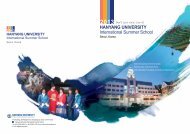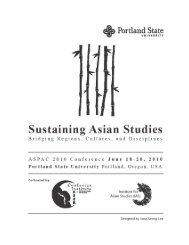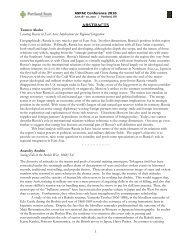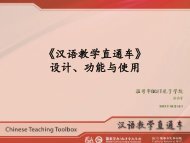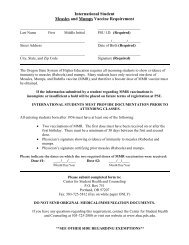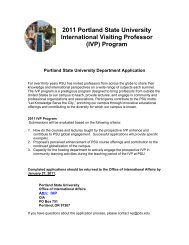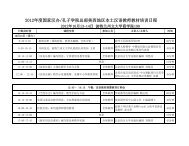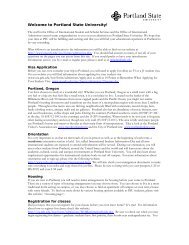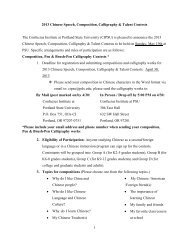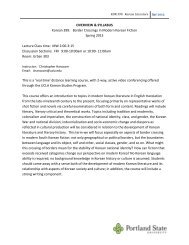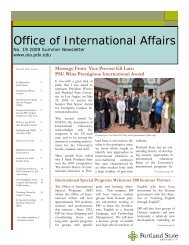International Student Handbook - Office of International Affairs ...
International Student Handbook - Office of International Affairs ...
International Student Handbook - Office of International Affairs ...
You also want an ePaper? Increase the reach of your titles
YUMPU automatically turns print PDFs into web optimized ePapers that Google loves.
VISA ISSUES<br />
Travel to Canada, Mexico and the Caribbean (F-1 & J-1 visa holders):<br />
Travel to these countries requires different documentation for most<br />
students than travel anywhere else in the world. In order to enter these<br />
countries, you must make sure that your I-94 form (the small white card) is<br />
valid for longer than the period you expect to stay in that country. If your<br />
I-94 card says D/S, this is sufficient, as long as you are not nearing the<br />
completion date indicated on your Form I-20 or DS-2019.<br />
In addition to a valid I-94 form, you will need to take along a valid passport<br />
and your valid I-20 or DS-2019 form. It is advisable to take evidence <strong>of</strong><br />
financial support, which could include a bank statement or scholarship<br />
letter from sponsor. A valid F-1 or J-1 visa is not necessary for re-entry into<br />
the United States from Canada, the Caribbean, or Mexico if your visit was<br />
for 30 days or fewer. Show the immigration <strong>of</strong>ficials your valid I-94 card<br />
when you enter Canada or Mexico (don’t let them take it) and you’ll present<br />
it again when you re-enter the U.S. <strong>Student</strong>s from Iran, Syria, Sudan and<br />
Cuba are not eligible for automatic visa<br />
revalidation and must therefore have a valid F1 or J1 visa as well as the<br />
other immigration documents if they wish to re-enter the U.S. from Canada<br />
or Mexico.<br />
NOTE: Depending upon your country <strong>of</strong> citizenship, you may need a visa<br />
to enter Canada, Mexico or the Caribbean. If you travel to these areas, you<br />
will need to contact the appropriate embassy in the U.S.<br />
Canadian and Mexican Embassies nearest to Portland State University:<br />
Canadian Consulate<br />
1501 4th Avenue, Suite #600<br />
Seattle, WA 98101<br />
(206) 443-1777<br />
www.canadianembassy.org/<br />
Mexican Consulate<br />
1305 SW 12th Avenue Portland, OR 97201<br />
(between SW Jefferson St and SW Columbia St)<br />
(503) 274-1450/1442<br />
www.sre.gob.mx/portland<br />
2. HOUSING OPTIONS IN PORTLAND<br />
HOUSING<br />
On-Campus Housing<br />
University Housing operates 10 on-campus buildings and houses<br />
approximately 2,000 resident students. On-campus housing is not<br />
guaranteed, so you are encouraged to research your housing options early.<br />
Some units in University Housing are in extremely high demand, especially<br />
most types <strong>of</strong> single, furnished rooms without roommates. This means it is<br />
very important that you submit your legally binding University Housing<br />
contract as soon as possible. The University Housing contract for the<br />
upcoming academic year generally opens in early March. Your priority<br />
during the housing assignment process is based on the date that the<br />
University Housing <strong>of</strong>fice receives your contract. To submit your housing<br />
contract, visit their website at http://www.pdx.edu/housing. The oncampus<br />
residence halls are convenient and provide support services and an active<br />
social atmosphere. Consider living on the Global Village floor which houses<br />
international students together with American students! All on-campus<br />
housing unit costs include the cost <strong>of</strong> utilities (electricity, water, gas, etc.).<br />
Off-Campus Housing<br />
Affordable housing in Portland is in demand and it may take you several<br />
weeks to find suitable permanent housing. The main campus is centrally<br />
located in downtown Portland. You may also want to consider living in<br />
nearby neighborhoods on both sides <strong>of</strong> the Willamette River which flows<br />
through downtown. The city is divided into four quadrants: southwest<br />
(SW), northwest (NW), southeast (SE), and northeast (NE), the Willamette<br />
River divides the east and west sides <strong>of</strong> the city and Burnside Street is the<br />
dividing line between north and south Portland. All <strong>of</strong> these areas are easily<br />
accessible to campus by public transportation. For more detailed<br />
information about housing in Portland visit the PSU Intensive English<br />
Language Program website at http://www.ielp.pdx.edu/housing.php



